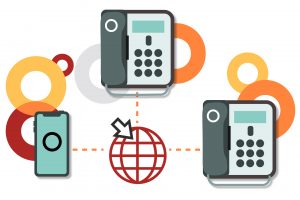Tile contractors today face numerous challenges. Missing calls from customers and prospects shouldn’t be one of them. Many have switched to voice over internet protocol (VoIP) systems from traditional landlines because of significant cost savings, the ability to work from anywhere (and still use your office phone number), and the numerous features VoIP provides.
This article aims to help tile contractors sort through the VoIP noise, get concise answers, and feel confident about switching to a VoIP system. For an even deeper dive, you can download the free VoIP Guidebook at www.ooma.com/business/voip-phone-systems/
What are VoIP phone systems?
Voice over Internet Protocol phones, as the name implies, use the internet to make and receive calls. Some service providers enable you to use analog phones, but the majority provide internet protocol (IP) phones that can be plugged into any Ethernet jack.
Once connected, you can make and receive calls. Using a web portal and login, you can customize features such as a virtual receptionist welcome message or adding new users.
VoIP vs. traditional landline phones
The most significant difference between VoIP and landline phones, in a word, is technology.
Landline phones haven’t changed much since the beginning of the 20th century and require an infrastructure of wiring and exchange hardware. By today’s standards, landline phone technology is limited, allowing users to only make and receive voice calls.
VoIP technology has changed how businesses literally communicate. While IP capabilities have been around several decades, VoIP services have advanced in recent years, thanks to innovation and faster internet speeds.
Unlike landline phones that require add-ons for features at additional costs, VoIP systems come with an array of popular communication features already built in.
How VoIP systems work
VoIP phones work by turning your voice into data, which is then transmitted over the internet, similar to sending emails.
If you’ve used Skype or WhatsApp Calling, you’ve used VoIP. VoIP calls are made on your phone, connected to the internet with a network cable or adapter, or via a computer’s microphone and speakers using an app. When making calls, the VoIP service provider routes the voice data between you and the other caller – all within a split second.

VoIP systems transform communications
As businesses grow, having a phone system that aligns with customers’ expectations is critical. Unlike traditional landlines, VoIP systems come with powerful features to help any size business make a big impression. These include:
Virtual receptionist – Missing new business because your phone is busy, or your greeting is unprofessional is easily resolved by a Virtual Receptionist. When a live person can’t take a call, the Virtual Receptionist takes over. Instead of hearing a busy signal or being put on hold, callers listen to a message and can be given options on how best to proceed.
Ring Groups – To ensure every caller has a positive experience, you can program Ring Groups to ring simultaneously – so everyone in a department, like sales, receives the call – or ring sequentially, to ring from person to person until someone picks up.
Mobility – Staying connected to customers when away from the office is critical today. It’s not practical or professional for employees to use their personal number for business. VoIP systems, unlike landlines, support working remotely through mobile and desktop apps, as well as voice messages forwarded as email attachments – allowing employees to make and receive calls from anywhere in much the same way they would from their work site.
Keep existing phone number – Keeping your business phone number, your lifeline, makes the transition to an IP system seamless. The moment you plug in your phones, you’ll be able to make and receive calls. No need to change business cards, letterhead and website information. Your VoIP service provider can easily take care of moving your business number to your new system.
Conference calling – If conference calls are an integral part of your work, you understand the need for a conference phone that delivers the perfect sound. If callers find it hard to hear participants, the meeting will be challenging. To ensure everyone experiences in-person call quality, look for a conference phone with the following features:
- A 360° voice range
- An array of built-in microphones
- Echo cancellation background noise suppression
- Most IP conference phones come with Bluetooth or Ethernet capabilities. Choose the connection that works best for you and make every conference call a success.
Key Advantages of VoIP Systems
Big impression – How customers perceive your business often depends on their initial phone interaction. Will they hear a welcome message with easy directions, or be put on hold immediately? Whether your business has two or 200 employees, your business will sound professional with a VoIP phone system.
Excellent call quality – With technology advances and increased internet speeds, your VoIP phones will provide the call quality you need.
Reduced costs – Lower costs are one of the most appealing benefits for switching to VoIP systems. Those with landlines understand the significant expense – setup fees, monthly costs, per-line expenses, etc. – all add up, including IT support. To calculate how much you could save by switching to a VoIP system, use the VoIP Savings Calculator at www.ooma.com/small-business-phone-systems/savings/.
Connect with remote teams – Employees today are working everywhere. A VoIP system provides the tools to communicate with staff effortlessly – no matter where employees are.


Ken Narita
Ken Narita’s marketing career spans two decades of helping businesses large and small grow. Whether advising emerging startups, guiding clients from the agency side or now leading SMB marketing at Ooma, Ken takes an empathetic approach to addressing goals, gaps, and opportunities. Ken has led demand generation, field marketing, customer marketing, and marketing operations teams, integrating campaigns across all functions to drive results. For more information, visit: www.ooma.com. For questions or comments, please email: [email protected].







